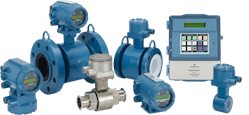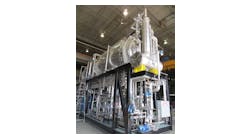At first glance, cooling water measurement might not seem to be an essential measurement to power generation or chemical operations. However, when delving into the value of cooling and temperature control, it becomes clear it cannot be an afterthought.
There are different systems that require cooling, whether in power generation or chemical process applications, and knowing the water used for the process of cooling and temperature regulation allows for accurate accounting and reporting. Considering that most often the water used in these instances comes from municipal sources, it stands to reason a facility wants to know how much they are using and where the wastewater goes after it has run through the process. Accounting for wastewater is also required for environmental reporting.
If the water used is taken from natural sources, other issues come into play, such as: Will the water require filtration? How clean is the water? What types of particles might be in the water that can contribute to corrosion of piping, pumps and flow measurement devices? And how much can particulate matter impact accurate measurement?
A facility will want to look into finding a flow meter that is not significantly impacted by the different types of impurities and still able to return reliable measurement data.
Efficiently cooling a process or maintaining a correct temperature is essential to the quality or outcome of the process. Though cooling water measurement is not generally seen as a critical measurement, cooling is an important part of keeping a process running and of what makes a heat exchanger a valuable piece of equipment. Efficiency in cooling is what keeps the process from bogging down if temperatures fluctuate or if the cooling process malfunctions. Any significant change in temperature can impact the process at various points down the line.
Process control with heat exchangers
Heat exchangers are a critical component in both power generation and in processes that require temperature regulation, such as chemical, refining or food and beverage processes. In chemical processes — similar to food and beverage — for example, there is often a blending stage in the process. But that blending can only happen if materials or ingredients are at the correct temperature, as temperature can impact viscosity, which will determine if a material can blend properly. This is one indication of how important a heat exchanger is in regulating temperatures.
Cooling water is what allows the heat exchanger to regulate the temperature by transferring the temperature from one fluid to another, in this case to the cooling water.
Power plants that use hydrocarbon or nuclear materials to generate power rely on heat exchangers to keep the processes running safely by preventing dangerous temperature excursions. Designs may differ, but heat exchangers in one form or another have a long history. Often the design features a series of tubes that allow the hot liquid or steam to flow through and the tubes are submerged in cold water which cools the material in the tubes by taking on the heat.
That basically describes the most commonly used type of heat exchanger — the shell-and-tube design. The bundle of tubes that the hot material goes through is immersed and then enclosed in a shell designed to let the cooling fluid to flow through the spaces between the tubes. In nuclear reactors, the fuel rods are placed in the tubes in the bundle. Cooling fluid flows around the rods and removes the heat generated by the fission process.
Looking at power plants that use a combustion type of process to create heat, they will often run the hot exhaust gases through the heat exchanger set up, instead of venting the gas directly to the outside environment. This way the gas is cooled, the heat is recirculated into the process and usually the gas is also run through a scrubber before being vented to the outside air.
Magnetic flow meters for efficient cooling water measurement
Cooling water performs an important function in different industries and processes. To ensure the cooling process runs as it should and there is an accurate accounting of the water used, water released — either into the sewer system or back into nature — and possible water lost through leaks, good measurement devices are needed.
The magnetic flow meter is ideally suited to measure flow rates and water usage for accurate temperature control. Operators can track the rate of flow and collect data on amounts of water used, while controlling temperatures throughout the process.
With no moving parts and an obstruction-less design (Figure 1), the magnetic flow meter is low maintenance and efficient. By pairing it with the right liner and electrode material, the likelihood of corrosive or obstructive deposits is dramatically reduced. Verifying a meter’s performance becomes routine with advanced diagnostic capabilities, especially when they are wireless enabled. Wireless data collection provides real-time data gathering, allowing an operator to respond quickly to changes in flow rate and temperature.
Meeting regulatory requirements
Regulations around water and wastewater, particularly when water is drawn from and returned to natural environments, are closely monitored. The water must be accurately measured and accounted for. In addition, cooling water that is returned, cannot be hot or even warm, as it could damage ecosystems in and around the body of water it is returned to.
Complying with regulations requires regular reporting of volumes of water used and discharged. Having that data easily accessible means savings in time and personnel needed to physically check each meter. Having relevant data available with a few keystrokes ensures accurate reporting.
Modernizing facilities
Closely tied to having wireless-enabled magnetic flow meters is the digitalization of data collection, storage and use. Wireless transmitters make it easier to install additional flow meters if and when the need arises, ensuring that cooling water flows efficiently and is measured accurately.
Accuracy in cooling of critical processes is not an afterthought and is an important component in many types of industrial facilities, bound by regulations and safety requirements to ensure safe and reliable results and consistent final products.
The right instruments ensure that building and maintaining a reliable cooling water system can be realized with a minimum of upsets or process fluctuations.
Cheng Vue is the global magnetic flow meter product manager for Emerson. Previously, he was the global product manager for Emerson vortex and temperature transmitters and has been working with Emerson for eight years. He has an MBA from Hamline University and a B.S. in mechanical engineering from the University of Minnesota Duluth.
Emerson



